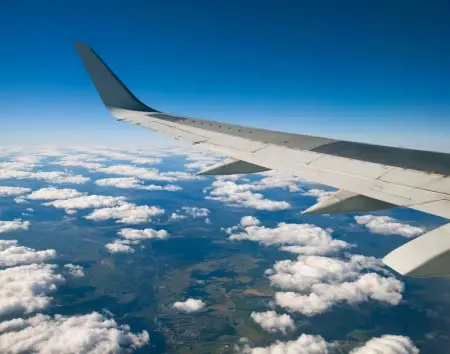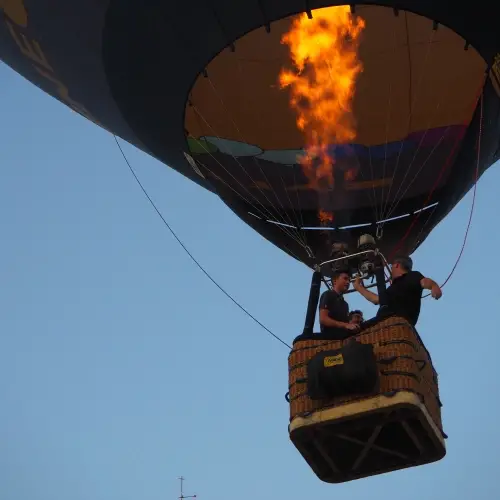
Airplanes fly thanks to a combination of physical principles acting on them, which allow them to generate the force necessary to stay in the air and move.
The most important of these are aerodynamics, lift, propulsion and flight control. These concepts will be explained in detail below, as well as the history and evolution of flight, leading up to modern aircraft.
Physical principles of flight
1. Support
Lift is the key to aircraft flight and is generated primarily by the wings.
To understand how it occurs, it is necessary to understand some basic principles of aerodynamics, such as Bernoulli's principle and Newton's third law.
Bernoulli's principle
 This principle states that the higher the speed of a fluid, the lower its pressure.
This principle states that the higher the speed of a fluid, the lower its pressure.
In the case of an airplane, the "fluid" is air. An airplane's wings have a particular shape, called an airfoil, which is curved at the top and flatter at the bottom. When the airplane moves forward, air flows over and under the wings. Because of the shape of the airfoil, the air passing over the top of the wing has to travel a greater distance in the same amount of time than the air passing over the bottom, causing the air over the top to move faster.
According to Bernoulli's principle, when moving faster, the pressure on the top of the wing is less than on the bottom. This pressure difference generates an upward force, known as lift, which lifts the aircraft.
Newton's law
In addition to Bernoulli's principle, Newton's third law, which states that "for every action there is an equal and opposite reaction," also plays an important role in generating lift.
The airflow deflected downward as it passes over the wing generates an upward reaction force, which also contributes to the aircraft's lift.
2. Propulsion
 The next key component in aircraft flight is propulsion, which is the force that propels the aircraft forward. This force is produced by the aircraft's engines, which can be jet engines (on most commercial aircraft) or propellers (on smaller or older aircraft).
The next key component in aircraft flight is propulsion, which is the force that propels the aircraft forward. This force is produced by the aircraft's engines, which can be jet engines (on most commercial aircraft) or propellers (on smaller or older aircraft).
Propulsion is what allows the aircraft to maintain sufficient speed for the wings to generate lift.
In the case of jet engines, they work by expelling gases at high speed backwards.
According to Newton's third law, the reaction to this ejection is a force that pushes the plane forward. In the case of propellers, they spin rapidly and push air backward, creating a forward force that moves the plane forward.
3. Resistance and weight
There are two additional forces that must be counteracted for an airplane to fly: drag and weight.
-
Drag: This is the force that opposes the movement of the aircraft through the air. It is produced due to the friction of the aircraft with the air molecules, which generates a friction that tends to slow down the aircraft. Aircraft designers work to reduce aerodynamic drag by giving them smooth and optimized shapes.
-
Weight: The weight of the plane, which is the downward force due to gravity, must be counterbalanced by the lift force in order for the plane to not fall. The lift must be greater than the weight in order for the plane to rise, and it must equal the weight in order for it to maintain stable flight.
4. Flight control
To control the direction and stability of the aircraft in the air, different control surfaces are used, located mainly on the wings and tail of the aircraft. These surfaces are:
- Ailerons: Located on the wings, they allow the aircraft to turn on its longitudinal axis, leaning to one side or the other (this is known as "roll").
- Rudder: Located in the vertical part of the tail, it controls the rotation of the aircraft on its vertical axis (a movement known as "yaw").
- Elevators: Located in the horizontal part of the tail, they control the inclination of the aircraft on its lateral axis, that is, they make the aircraft go up or down (a movement called "pitching").
5. Speed and altitude
The speed of the aircraft is crucial for lift to occur. At low speeds, the amount of air passing over the wings is not sufficient to generate the necessary lift, and the aircraft may lose altitude or even enter a stall condition (when the airflow over the wing separates from its surface and the wing stops generating lift).
For this reason, aircraft need to reach a minimum speed to take off and stay in the air. Once in flight, they must maintain an appropriate speed depending on the altitude and flight conditions.
As for altitude, as the aircraft climbs, the density of the air decreases, which can affect both lift and engine efficiency. Airplanes are designed to fly at altitudes where the air is less dense, which reduces aerodynamic drag and allows for more efficient flight. However, pilots must take atmospheric conditions into account and adjust speed and angle of attack (the pitch of the wing relative to the airflow) to maintain stable flight.
Comparison with helicopter flight
 Airplanes and helicopters fly using similar aerodynamic principles, but there are key differences in how they generate lift and are controlled in the air.
Airplanes and helicopters fly using similar aerodynamic principles, but there are key differences in how they generate lift and are controlled in the air.
Generation of support
- Airplanes : Generate lift through their fixed wings. To fly, they must move forward, allowing air to flow over the wings and create a pressure difference that keeps them in the air.
- Helicopters : Generate lift by means of their rotors , which act as rotating wings. The helicopter's main rotor spins rapidly and moves air downward, creating an upward reaction force, allowing takeoff and vertical flight without the need for forward motion.
Propulsion
- Airplanes : Use jet engines or propellers to generate the forward thrust force necessary for air to flow over the wings and produce lift.
- Helicopters : They do not need to move forward to fly. The main rotor not only provides lift, but also thrust, allowing the helicopter to move in any direction (forward, backward, and sideways).
Control
- Airplanes : They use ailerons, rudders and elevators to control flight. These allow them to turn and go up or down, but they always need to move forward.
- Helicopters : They control flight by adjusting the angle of the rotors (cyclic and collective) and using the tail rotor to control yaw, allowing them to take off and land vertically, and to hover.
Comparison with the flight of a hot air balloon
 The flight of an airplane and that of a hot air balloon are based on completely different principles as to how lift, propulsion and control are generated.
The flight of an airplane and that of a hot air balloon are based on completely different principles as to how lift, propulsion and control are generated.
Generation of support
- Airplanes : Generate lift through their fixed wings. For the plane to fly, it needs to move forward, allowing air to pass over the wings and generate a pressure difference that keeps it in the air.
- Hot air balloons : These do not generate lift through motion or wings. Instead, they operate based on the principle of buoyancy or Archimedes' principle , which states that an object submerged in a fluid (in this case, air) experiences an upward force equal to the weight of the fluid displaced. The warm air inside the balloon is less dense than the cold air surrounding it, causing the balloon to float upward.
Propulsion
- Airplanes : They use engines (jet or propeller) to generate forward thrust, allowing them to move forward and generate the lift necessary for flight.
- Hot air balloons : They do not have an active propulsion system. The balloon simply floats with the air currents, being unable to intentionally move in a specific direction. It only rises or falls by heating or cooling the air inside it.
Control
- Airplanes : Use control surfaces (ailerons, rudder, elevators) to maneuver in the air. Pilots have control over direction, altitude, and speed.
- Hot air balloons : Control is much more limited. Pilots can control only altitude by adjusting the amount of heat in the balloon, but direction depends on wind currents, as the balloon has no direct control over its horizontal displacement.
Evolution of human flight
The pioneers of flight
The idea of flight has fascinated mankind since ancient times. However, it was not until the late 19th and early 20th centuries that the first controlled and sustained flight was achieved.
The Wright brothers, Orville and Wilbur, achieved this milestone on December 17, 1903, with their airplane Flyer I. This aircraft was equipped with fixed wings and one engine, and its success was the result of years of research in aerodynamics, flight control, and light engines.
Development of commercial aircraft
As technology advanced, larger and more efficient aircraft were designed. During World War I and II, military aviation drove many advances in aircraft design, which later carried over to commercial aviation.
Airplanes began to be used for the transport of passengers and cargo, and civil aviation grew exponentially during the 20th century.
One of the most important milestones in commercial aviation was the development of the Boeing 707 in the 1950s, one of the first commercial jet aircraft. This aircraft revolutionized air travel by allowing faster, longer-distance flights, and marked the beginning of the jet era.
Modern Aircraft
Today, airplanes are highly sophisticated machines, with advanced navigation, control and safety systems. Modern commercial aircraft, such as the Boeing 787 Dreamliner or the Airbus A350, are designed to be extremely fuel efficient and reduce carbon emissions.
In addition, improvements in composite materials and aerodynamics allow aircraft to be lighter, reducing weight and therefore fuel consumption.
The introduction of technologies such as high-efficiency engines and the use of lightweight composite materials has allowed modern aircraft to become quieter and more economical.
Automation has also played a key role in flight control, with autopilot systems allowing aircraft to fly predetermined paths with minimal human intervention.